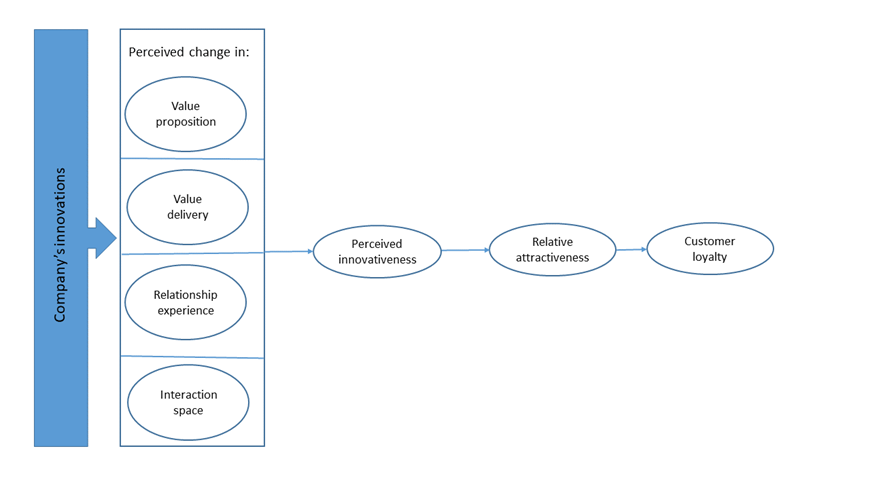Technical description
The Norwegian Innovation Index research model.
NII as brand name comprises three indexes:
CII – Commercial Innovation Index ranks firms by commercial innovativeness.
SII – Social Innovation Index ranks firms by the perceived contribution to society through innovation.
DII – Digital Innovation Index ranks firms by digital innovativeness.
Togethe with Bekk Consulting, we report on these three rankings annually.
As a strategic tool, NII provides an insight into dynamic processes of change in value co-creation. To capture these dynamics, the NII team has taken several innovative steps forward from the logic of satisfaction indices.
- As a growing body of research suggests, it is unrealistic that customers develop clear perceptions about each existing and new element in a company’s product portfolio. From the customer perspective, product- and attribute-level innovations are merely a means of solving customer problems, realizing value, and reconfiguring relationships in a novel way and in a given context. Accordingly, NII captures customers’ reactions to changes in the dimensions of value co-creation resulting from product- and attribute-level innovations, namely value proposition, value realization, relationship experience, and interaction space.
- Innovation launches create cognitive and emotional responses that may be short-lived and yet have a profound influence on customers’ beliefs, attitudes, and associations. In many cases, innovation effects may arise long after the launch. To better capture such effects across time, the NII data are collected on an annual rolling basis, which allows conducting both year-over-year and quarter-over-quarter comparisons and even quasi-experimental studies.
- Although the Customer is Innovation Judge, NII acknowledges the fact that innovations are launched by firms. To capture firms’ actual launches, the NII team annually runs an additional qualitative study where marketing directors of the firms on the ranking list present concrete changes they made in the previous year. In addition, customers participating in the main quantitative study have a chance to share their thoughts on companies’ activities in a text field. This allows direct comparison of managers’ and customers’ perspectives on innovation based on the actors’ own reflections and vocabulary.
Through a professional bureau (Norstat), the NII team annually collects more than 23000 responses from customers of about 90 companies in 20 industries. The constructs and measures are theoreticallly derived and validated through a series of pretests.

NII: Research model
Sampling of Companies
For feasibility reasons, NII does not cover all existing companies. In selecting companies, NII applies the following criteria:
1) companies have to represent industries with the highest proportion of household spending, jointly accounting for a minimum 70% of all household consumption.
2) companies have to account for a minimum 70% of the respective markets within each of the selected industries.
Sampling of Respondents
NII relies on a nationally representative sample of Norwegian population aged 15 years or older.
Norstat recruits respondents from their own, nationally representative web-panel that consists of about 23 000 individuals.
The size of the web-panel allows multiple representative sampling based on gender, age, and geographical location. The panel’s annual turnover is under 15%, and there is a continuous recruitment to restore and increase the number of participants.
Self-selection to the panel is not possible; the recruitment process is based on random selection and typically starts with a telephone or a face-to-face invitation.
The participation relies on a point-based incentive system (earned points may be exchanged to gift cards or charitable donations). The panel members are regularly interviewed on their motivation, the panel’s functionality, and the number and length of surveys to maintain the overview of the reasons for participation and withdrawal.
When constructing the annual NII, the team uses quarterly data. In the beginning of a quarterly survey, randomly selected panel members identify from a list of companies those firms that they regularly used during the last six months.
Each respondent then fills the questionnaire for up to three companies that are randomly selected from those identified by the respondent.
The team recruits about 300 respondents per company. These are the company quotas, which are filled by a random drawing from the nationally representative sample of respondents during a calendar year.
Ranking
The ranking is based on factor scores that are calculated using structural equation modeling. This provides a more precise estimation as compared to weighted averages of observed variables. The factor scores on each data point are then extracted, normalized, and used to calculate the mean scores of the constructs on a 100-point scale.
Interviews
In addition to the large-scale data collection from customers, the NII team conducts annual interviews of the marketing directors of the firms in the NII sample (in the beginning of a year, by phone).
The marketing directors answer questions on various innovations that their companies introduced during the last year.
The structure of the interview guide mirrors the dimensions of value co-creation: innovations in value proposition, value realization, relationship experience, and interaction space.
These data are categorized and compared with data from customers by the means of computer-assisted and manual analysis techniques.
